As many of us already know, bathrooms are exceptionally prone to mildew and mold, thanks to the high humidity of the space during and after showers. When a bathroom is well-built and properly maintained and cleaned, mold will find it harder to grow. But even with all our efforts at wiping down tiles, airing out the bathroom, and running ventilation fans, this yucky stuff will still take over.
If you love plants, you’ll be happy to hear that there are some incredible flora that can help you fight mold in the bathroom while adding some beauty and brightness to the space. The list below isn’t comprehensive, but it will get you started with ten of the easiest to find and most beautiful plants that will love helping you soak up some moisture in the bathroom.
10 Bathroom Plants That Absorb Moisture
Ten of the top bathroom plants to help reduce moisture include:
- Peace Lily
- Spider Plant
- Snake Plant
- English Ivy
- Pothos
- Azalea
- Boston Fern
- Reed Palm
- Bird’s Nest Fern
- Orchids
Peace Lily
If you like the idea of a year-round blooming plant that thrives in humid spaces, look no further than the peace lily. This beautiful flowering tropical plant can grow up to 3 feet tall (great for larger bathrooms!) and produces beautiful dark green leaves and white to pale green flowers.
They don’t require a lot of light, which is great for bathrooms with tiny windows, though more light will produce more blooms more frequently. Peace lilies also only need to be watered when the soil is dry. They need to be protected from cold drafts and fast temperature changes, though, so be sure to consider that when you place them.
Bonus: peace lilies are also known for helping to detoxify the air. The dark green leaves soak up many toxins in the air, including ammonia.
You can easily find peace lilies for sale online, at local garden centers, nurseries, and even stores like Walmart and Home Depot.
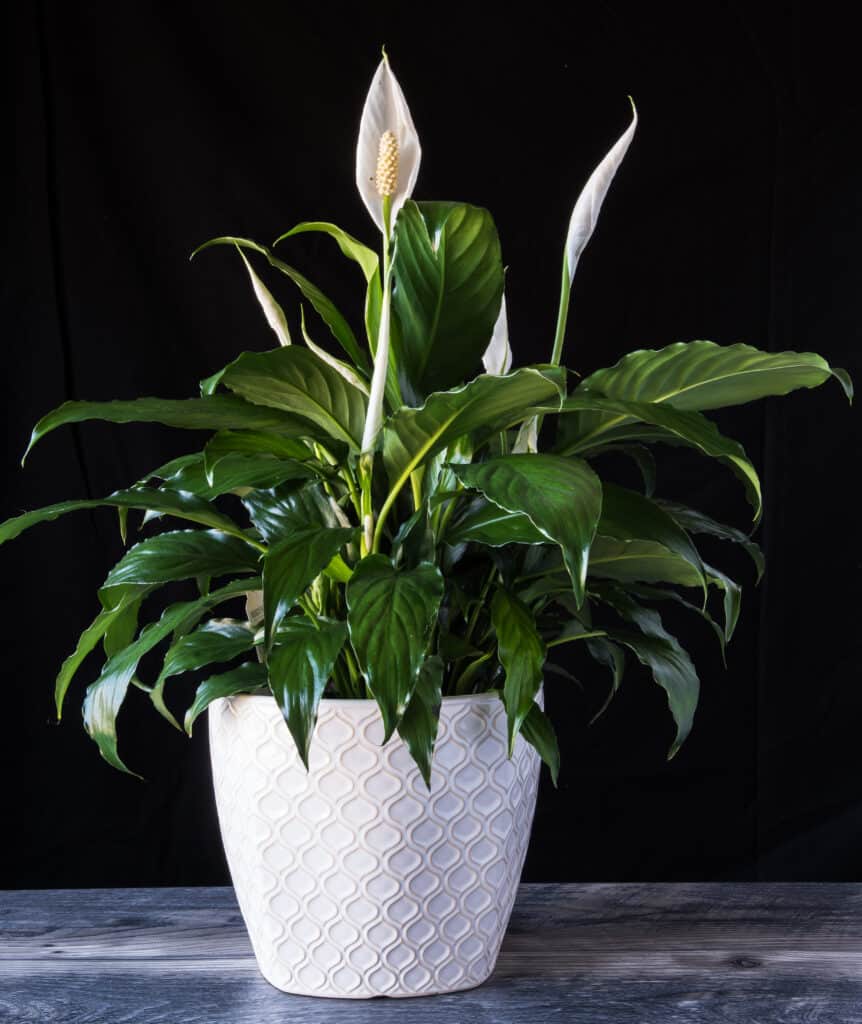
The peace lily thrives in humid spaces and does not require much light making it an ideal plant for bathrooms.
©Simone O/Shutterstock.com
Spider Plant
One of the easiest plants you’ll ever grow and propagate is the spider plant. The beautiful greenery adds brightness, with the little spider-looking shoots that pop out and spread quickly mean you can easily grow more plants or larger ones without much effort. They’re especially great for hanging baskets and climber settings.
This herbaceous perennial soaks up humidity like its life depends on it. It also helps to remove pollutants from the air and grows up to 2 feet. You basically don’t have to do anything for this plant, rarely needing to water it, and it doesn’t need much light.
Spider plants can be found for sale online and at nurseries, garden centers, and practically anywhere you find gardening supplies.

An easy to grow option for your bathroom is the spider plant with shoots that spread quickly without much maintenance.
©Bozhena Melnyk/Shutterstock.com
Snake Plant
A gorgeous evergreen perennial, snake plants are extremely hardy and great for keeping in pots in your bathroom. They soak up the water from the air while thriving in medium to low light. They require little care, too, meaning they’re great for busy people and folks who aren’t as familiar with caring for houseplants.
Snake plants grow up to 3 feet in height in most cases (8 feet in larger pots and spaces), rarely need watering, and do great in any type of lighting situation. Really, the only way you can mess up with this plant is if you overwater it. Instead, let it soak up the water in the bathroom air and water only when the soil is dry.
Find snake plants online or at local nurseries and garden centers for best results.

The hardy snake plant requires minimal care and will soak up water from the bathroom air.
©Olena758/Shutterstock.com
English Ivy
Perfectly suited to hanging baskets, English ivy is another great choice for your bathroom houseplants. They not only help soak up some of that humidity in the bathroom, but they also pull impurities from the air.
The plant is low maintenance, requiring little watering and care, and low lighting. But they do need to have the soil kept moist. Ivy is a vine, so it will grow and expand, too, adding more to the space. Ideally, you’ll hang the plant near something the vine can spread out to (say a decorative ladder or lattice style décor or even an extra tension rod). And if you mist the leaves daily, they’ll do exceptionally well and won’t need watering save about once a week.
You’ll find English ivy for sale at nurseries, local gardening centers, and some stores like Walmart and Home Depot.
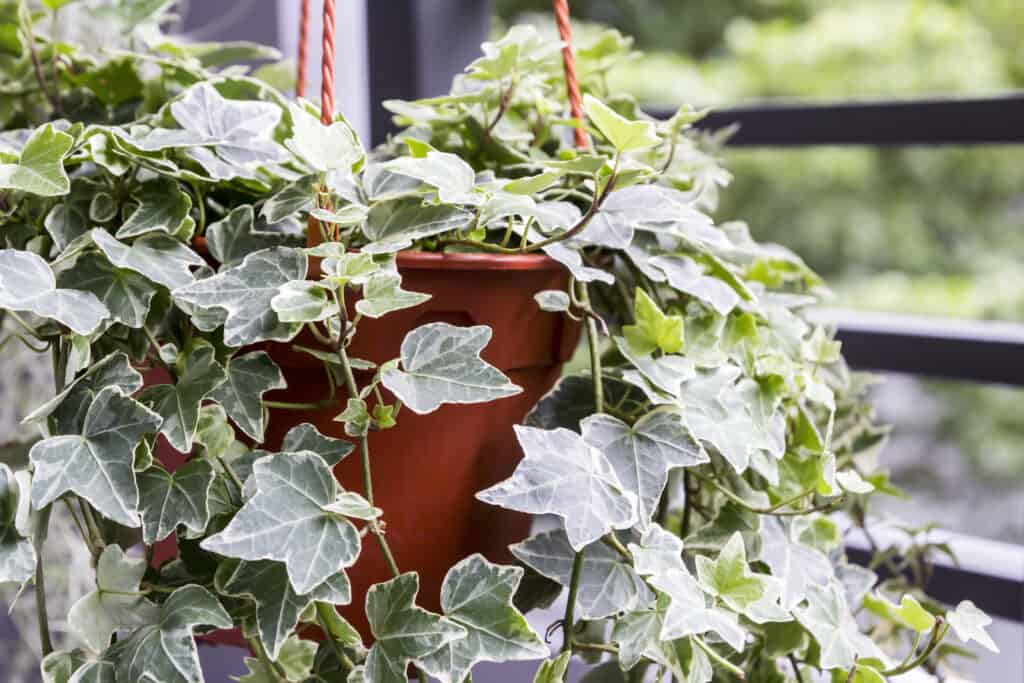
English ivy does well as a hanging plant and will soak up a bathroom’s humidity.
©ArtBackground/Shutterstock.com
Pothos
Another hardy vine that makes for a great indoor bathroom plant is pothos. The plant is often referred to as a cubicle plant, meaning it does well in just about any kind of space. It will thrive in that high humidity of the bathroom and spread out on the props you give it.
Plus, they don’t require a regular watering schedule and do fine in low light. The more light the plant does have, though, the faster it will grow. You can hang the plant from your curtain rod and let it run wild, soaking up the extra water from the shower.
Find pothos plants at your local nursery for best results.
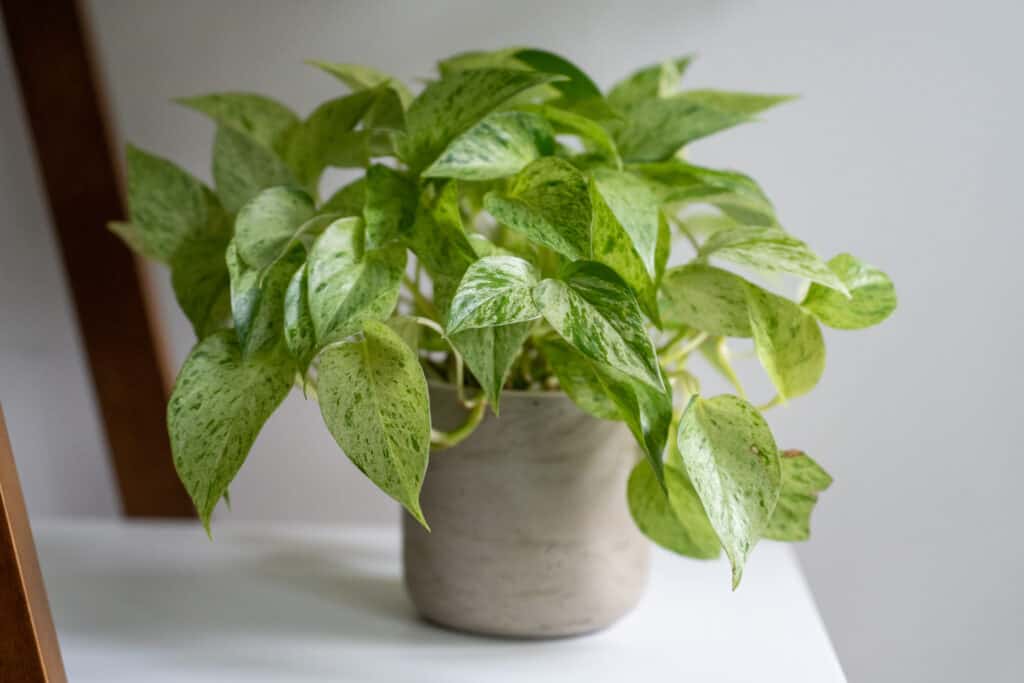
Pothos is a vine that thrives in humidity, can do well even in low light, and requires minimal watering making it a great bathroom plant.
©iStock.com/Jenny Sun
Azalea
For a splash of color throughout the year, a small azalea plant can do the trick. The beautiful blooming flower plant can be potted and kept indoors in the bathroom, despite being a shrub. Certain azalea varieties are better suited to indoor planting, of course, so be sure to look for smaller varieties and miniatures.
Azaleas naturally grow in higher humidity areas (think Florida, for example), so when they’re kept in the bathroom, they help suck in some of that humidity to keep healthy and happy on its own. For placement, they’ll do best with morning sun in the window.
Azaleas come in a variety of colors, as well, including white, pink, maroon, orange-red, pink, fuschia, purple, and other shades leaning in reddish shades.
You can purchase azalea plants online, at nurseries, and your local garden centers.
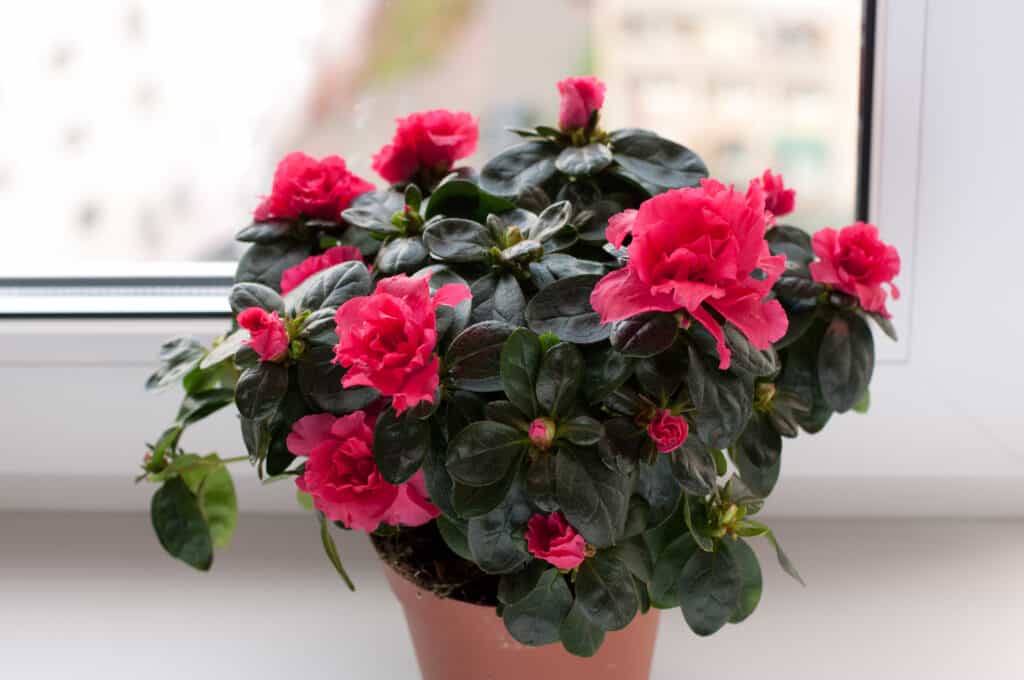
Brighten up your bathroom with a beautiful azalea plant and its colorful flowers.
©iStock.com/OlgaVolodina
Boston Fern
Boston ferns are the kind of plant that doesn’t tolerate high temperatures but needs humidity. This makes it the perfect choice for a bathroom where the shower runs often and mold might otherwise be a huge problem.
Boston ferns do well as hanging plants and grow up to 3 feet. They need indirect light and that high humidity, especially in wintertime. Misting it daily will help maintain that healthy color and vibrant life.
Boston ferns can be found for sale online, at nurseries, and local gardening centers most easily.
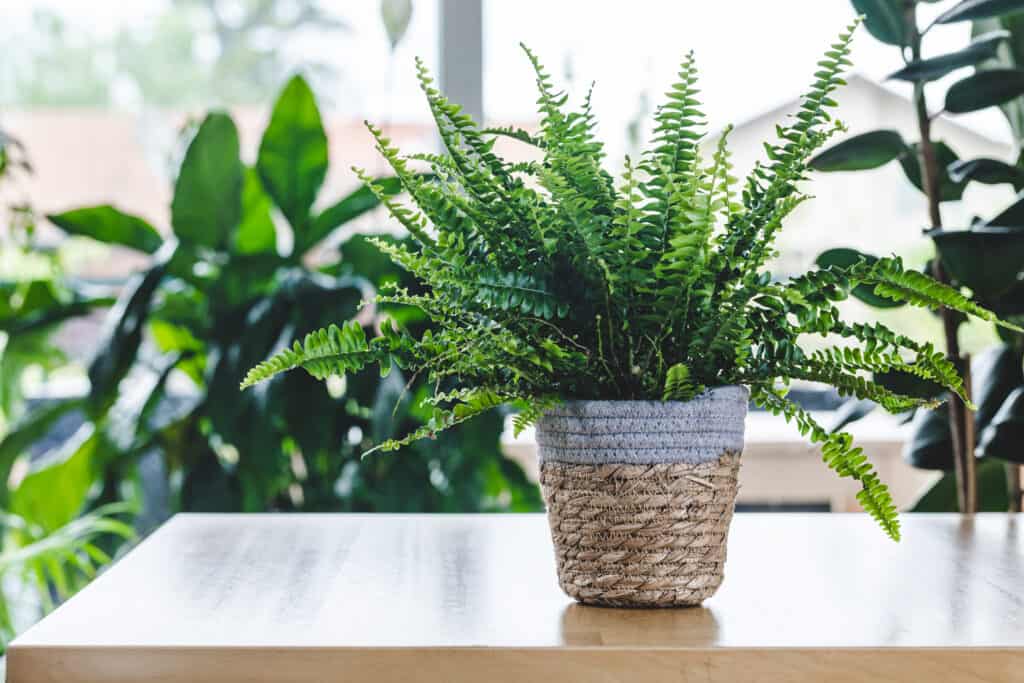
Boston ferns need high humidity and can grow up to 3 feet.
©iStock.com/Benoitbruchez
Tillandsia
If you enjoy a unique, exotic looking plant, then Tillandsia is your pick for the humid bathroom at home. The annual grows up to 6 feet and loves light (both indirect and direct, partial or full sun).
It’s a hardy plant, though, capable of surviving a good bit of neglect, and actually only wants to be watered every other week. Soak the plant in tap water for a few minutes and you’re done. The humidity in the bathroom takes care of the rest. The plant doesn’t grow in soil, meaning it’s an air plant that soaks up water through its leaves, rather than roots in the soil.
Tillandsia may be available for purchase online, at local nurseries and garden stores, and occasionally at stores like Home Depot and Lowes.
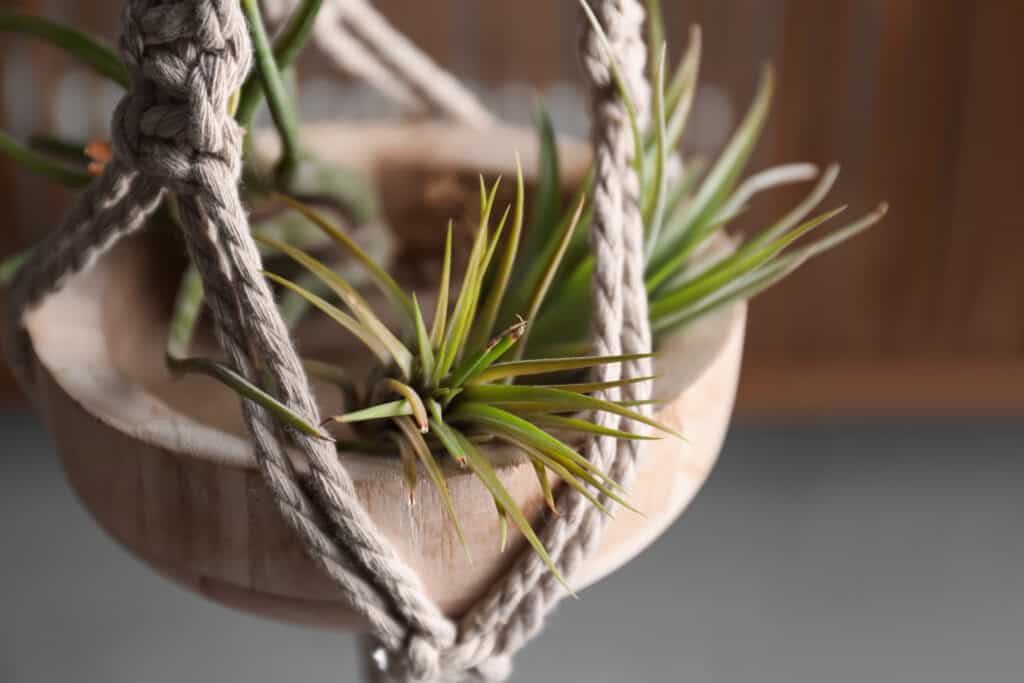
Tillandsia is an air plant that requires no soil, soaking up water through its leaves, rather than roots.
©iStock.com/Liudmila Chernetska
Bird’s Nest Fern
Happily growing in low light conditions, the bird’s nest fern is a gorgeous option for your bathroom potted plant family. The fern does grow up to 5 feet, though, so make sure it’s not in the closet bathroom in the hallway!
The fern loves lower light levels and tons of moisture, needing watered only once weekly as long as that shower keeps running through the week. They do need some light, of course, though, but you’ll know if there’s not quite enough light, if the fronds flatten out instead of staying wavy.
Find bird’s nest ferns online, at nurseries and for sale at garden centers.
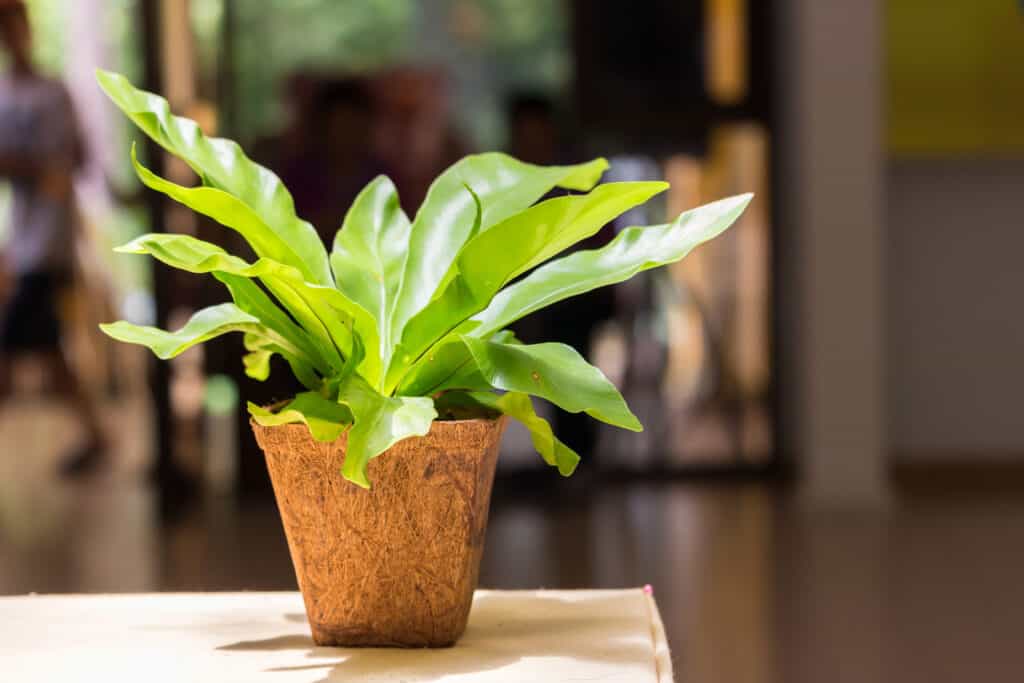
Bird’s nest fern does well in low light conditions and can grow up to 5 feet.
©Toey Toey/Shutterstock.com
Orchids
Orchids are incredibly well-suited to being kept as indoor plants. They like the same temperatures that most humans prefer for one, plus they don’t mind low light and humidity. This means they’re perfect for your bathroom. And when properly cared for, they will bloom with gorgeous, vibrant flowers for several months at a time.
Depending on the variety of orchid, you’ll find dozens of color and size options, ranging from 12 inches to 16 inches in height, and colors including red, pink, white, blue, purple, green, orange, yellow, off-white, pale purple, and more. These plants are the most difficult to care for on our list, though, so be sure to read up on full care before attempting to grow them.
You’ll find orchids for sale in many locations, but if you’re not particularly experienced with orchids, it’s recommended you go to a local nursery or garden center where you can receive personalized experience and care as you choose your orchids.

Orchids can add vibrant colors to your bathroom.
©Summer 1810/Shutterstock.com
Up Next:
- Discover the Best Black Houseplants for Your Elegant Home
- 8 Houseplants That Grow in Water
- 10 Houseplants That Are Nearly Impossible to Kill
The photo featured at the top of this post is © ArtCreationsDesignPhoto/Shutterstock.com
Sources
- Planters Etc, Available here: https://plantersetcetera.com/blog/bathroom-plants-that-absorb-moisture/
- Swansons Nursery, Available here: https://www.swansonsnursery.com/blog/pothos-indoor-plant
- PennState Extension, Available here: https://extension.psu.edu/tillandsia-air-plants
- Azalea Society of America, Available here: https://www.azaleas.org/about-azaleas/
Thank you for reading! Have some feedback for us? Contact the AZ Animals editorial team.






